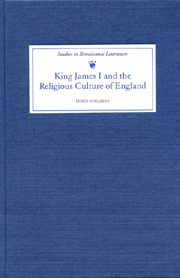Book contents
- Frontmatter
- Preface
- Chapter 1 BEGINNINGS: THE ROOTS OF JAMES' ROLE IN RELIGIOUS CULTURE
- Chapter 2 THE ACCESSION OF KING JAMES I AND ENGLISH RELIGIOUS POETRY
- Chapter 3 PROPHETS AND THE KING
- Chapter 4 KING JAMES, ANDREW MELVILLE AND THE NEO-LATIN RELIGIOUS EPIGRAM
- Chapter 5 FROM CONSTANTINIAN EMPEROR TO REX PACIFICUS: THE EVOLVING ICONOGRAPHY OF JAMES I
- Chapter 6 KING JAMES AND THE POLITICS OF CONVERSION
- Chapter 7 THE SONGS OF DAVID: KING JAMES AND THE PSALTER
- Chapter 8 THE DEATH OF SOLOMON
- WORKS CITED
- Index
Chapter 6 - KING JAMES AND THE POLITICS OF CONVERSION
Published online by Cambridge University Press: 05 February 2013
- Frontmatter
- Preface
- Chapter 1 BEGINNINGS: THE ROOTS OF JAMES' ROLE IN RELIGIOUS CULTURE
- Chapter 2 THE ACCESSION OF KING JAMES I AND ENGLISH RELIGIOUS POETRY
- Chapter 3 PROPHETS AND THE KING
- Chapter 4 KING JAMES, ANDREW MELVILLE AND THE NEO-LATIN RELIGIOUS EPIGRAM
- Chapter 5 FROM CONSTANTINIAN EMPEROR TO REX PACIFICUS: THE EVOLVING ICONOGRAPHY OF JAMES I
- Chapter 6 KING JAMES AND THE POLITICS OF CONVERSION
- Chapter 7 THE SONGS OF DAVID: KING JAMES AND THE PSALTER
- Chapter 8 THE DEATH OF SOLOMON
- WORKS CITED
- Index
Summary
“but unmoved thou/Of force must one, and forced but one allow”
(John Donne, “Satire 3”)AROUND 1614, the Dutch painter Adriaen Pietersz. van de Venne produced a canvas entitled “Fishing for Souls”, which shows a wide river, with crowds of men portrayed on either bank – well-known Protestants on the right-bank of the river, and Roman Catholics on the left. In the midst of the river are a number of boats, each attempting to haul in various swimming or drowning figures. The painting effectively conveys the vigour with which the two halves of western Christendom attempted to win converts, especially converts of political or scholarly significance. The year of the painting is also significant, for while this battle for allegiance was ongoing from the Reformation, it reached a period of intensity from about 1607 to 1618. As David Mathew notes, in 1614 “there began the slow piecemeal conversion [to the Church of Rome] of small individual princes”, and these years were also a period of intense conversion activity within England. Prominently appearing on the right bank in the painting is King James, along with his daughter Elizabeth, and her husband, Frederick, Elector of the Palatine. The painting appropriately presents King James as a figure deeply concerned with significant conversions, both within England and across Europe.
- Type
- Chapter
- Information
- King James I and the Religious Culture of England , pp. 102 - 134Publisher: Boydell & BrewerPrint publication year: 2000

